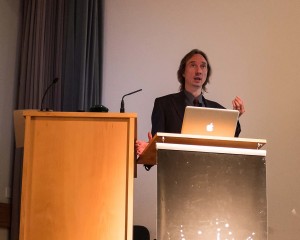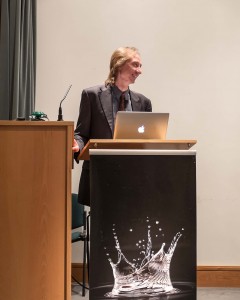October 14, 2013
The Day Without Yesterday
Dr Stuart Clark
Report by: Mike Meynell and Chris Sutcliffe
The Flamsteed were delighted to welcome back Dr Stuart Clark, a regular visitor to the society. Stuart has recently been awarded the 2013 European Astronomy Journalism Prize, which was richly deserved, his prize being a trip to Chile to see the telescopes in the Atacama Desert. We hope he has a fantastic trip. His articles in the national press and in astronomy magazines always make for fascinating reading. It was on the subject of his latest book “The Day without Yesterday” that he came to the Flamsteed to give his talk.
For the last few years, Stuart has been dramatising some of the key moments in the history of astronomy. His “Sky’s Dark Labyrinth” trilogy starts first with the story of Kepler and Galileo, then moves on to the time of Newton, before finishing with the story of Albert Einstein and Georges Lemaitre. The books focus on moments in history when we had to fundamentally change our perceptions of the universe, and look at it in a completely different way. Stuart realised that to properly tell these stories, it was necessary to describe the historical context of the times in which these great scientists lived. To do this, Stuart used the method of historical fiction.
The last book in Stuart’s trilogy, “The Day without Yesterday”, is based on the story of Einstein and Lemaitre. Lemaitre was the first person to propose a theory of the expansion of the Universe, a theory he discovered buried in the maths of the theory of general relativity, meaning that there must have been a moment when the universe came into existence… a day without yesterday.
However, Stuart opened his talk by trying to put this discovery into context. He began with Kepler and Galileo. Kepler was a remarkable figure, devoutly religious, and a brilliant mathematician. He truly believed that an explanation of the universe would be written in the language of mathematics, a language that he saw as divine and a method of unlocking the architecture of the universe.
He synthesised 30 years of observations of Tycho Brahe and came up with his three laws of planetary motion. These laws apply not just to the planets that Kepler knew about, they also applied to the planets that were discovered after Kepler (Uranus and Neptune). They also hold true for the many exoplanets that have been discovered in recent years orbiting around stars other than the Sun. An extraordinary achievement. Stuart believes that this was the watershed moment in rational human thought – decades of observations could be summarised in just three lines of mathematics.
Galileo, at the same time in Italy, was doing essentially the same thing, but for Earthly motion; trying to describe mathematically how objects fall to the ground.
However, neither Kepler nor Galileo knew why objects moved as they did. That was where Newton comes in. Newton brought in the concept of gravity, showing how Galileo’s and Kepler’s laws could be derived using this concept – a force of attraction that is proportional to the mass of the objects and the distance between the objects. Out of this came a way of describing how forces acted upon objects and cause movement. A truly revolutionary concept. Newton described this as a system of the world (we’d now call this a theory of everything).
However, Newton was aware that there were two main problems with his theory. First of all, he didn’t know what the nature of gravity actually was. Secondly, he could not understand why the stars stayed in the sky, seemingly unchanged – why were they not collapsing towards us if the force of gravity was acting on them. This is when Newton developed the concept of the “Sensorium of God” – he believed that since the universe should have been collapsing under the force of gravity and it wasn’t, this could only mean that gravity was the will of God – God’s right to either let things fall or to hold them up. In this way, Newton believed that he had proven the existence of God through his law of gravity.
In the 19th century, the measurement of the motion of the planets becomes accurate enough for observers to realise that there was a deviation from what Newton said should have been happening, particularly in relation to the orbit of Mercury. This brought us to Albert Einstein.
In 1914, Einstein moved from Zurich to Berlin. As part of the rise of nationalism in Germany at that time, Berlin became established as a world centre for science, as Germany wanted to be recognised as a world leader. Fritz Haber, the German chemist and friend of Einstein, was instrumental in persuading Einstein to come to Berlin. It was still a peculiar move, as Einstein hated nationalism, but Einstein may also have been tempted not just because Berlin was a world centre for science, but also because he was having an affair with Elsa, his cousin, who lived in Berlin. Einstein eventually divorced his wife and married Elsa after the end of World War I.
Einstein was intrigued by the deviations in the orbit of Mercury and was determined to find a solution. It was clear that the orbit was not obeying Newton’s laws. Mercury’s orbit has a precession – the point of closest approach of Mercury to the Sun does not always occur at the same place, but that it slowly moves around the Sun. This discrepancy cannot be accounted for using Newton’s theories.
Einstein looked back at the work he did in his theory of special relativity in 1905. How do we compare observations of supposedly simultaneous events witnessed by different observers in different places? If, for example, a person were standing on a bank whilst a train passes, and two bolts of lightning appear to strike the front and back of the train at the same time, how would an observer on the train witness the event? For the observer on the train, the front of the train is struck first, and then the back. Who is right? Einstein realised that they are both right, as you must take into account the observer’s relative velocity. This affects how we see events in the universe.
The important aspect of this is that the events appear to occur at different times for the two observers. This shows that time, like your position, is relative. There is no such thing as absolute time. The only way to compare the events is to take your velocity into account. This was the key conclusion of the special theory of relativity. Einstein knew, however, that this theory only stood if the velocity were constant. The theory did not cover accelerated motion. Einstein realised that, if he were to come up with a more general theory that included accelerated motion, he would have a mechanism for explaining the theory of gravity, as the only observable aspect of the nature of gravity is that it accelerates objects. This, he hoped, would give a mechanism for explaining the orbit of Mercury.
Newton had conceived of a rigid framework, or grid, of space, through which the celestial objects move. Einstein started to realise that the presence of matter and energy would have the effect of compacting this grid system – when objects move through this compacted region, they appear to cross faster and therefore give the appearance of accelerated motion.
He needed to turn this theory into numbers, something that was measurable. He realised that if space is shaped in the way he predicted, then light rays would follow the path of the curves through space, meaning that they would be deflected by the presence of large objects. The easiest way to test this was during a total eclipse of the Sun, when light rays from distant stars that appear close to the Sun could be observed to deflect due to the mass of the Sun, if he was right.
The First World War meant that this measurement couldn’t be made until 1919. Eventually, Arthur Eddington, the British astrophysicist, led an expedition to the island of Principe to watch the solar eclipse of 29 May 1919. During the eclipse, he took pictures of the stars in the region around the Sun. When measuring the plates, Eddington confirmed Einstein’s theory, and was hailed at the time as a conclusive proof of general relativity. For a world that was sick of war, the theory was seized upon by the newspapers and the general public as a glimpse into a better, more progressive, world. What could be better than a new understanding of the universe, even if the mathematics of that theory were beyond most people.
One of the people who clearly understood the theory was Georges Lemaitre, a Belgian physicist and astronomer, who was also a Catholic priest. Lemaitre realised that Einstein’s equations were unstable. A tiny deviation would set the universe expanding. In fact, the equations gave a prediction for how fast the expansion of the universe should be. That prediction was very close to Hubble’s observation of the expanding universe in 1929. However, Lemaitre had predicted this expansion two years previously, in 1927, but it was published in an obscure journal that nobody took any notice of.
Lemaitre went on to postulate that if the universe were expanding now, it must have been smaller in the past. When we ran the equations backwards, he realised that there was a point when everything was compacted together – the beginning of the universe. There must have been a “day without yesterday”, a moment when time began. We now call this the “Big Bang”.
Once again, this was a fantastic lecture by Stuart, which had the Flamsteed audience utterly engrossed. Our thanks to Stuart for coming to the Flamsteed once again.
Posted under: Flamsteed, Flamsteed Lecture, Meeting Report



You must be logged in to post a comment.